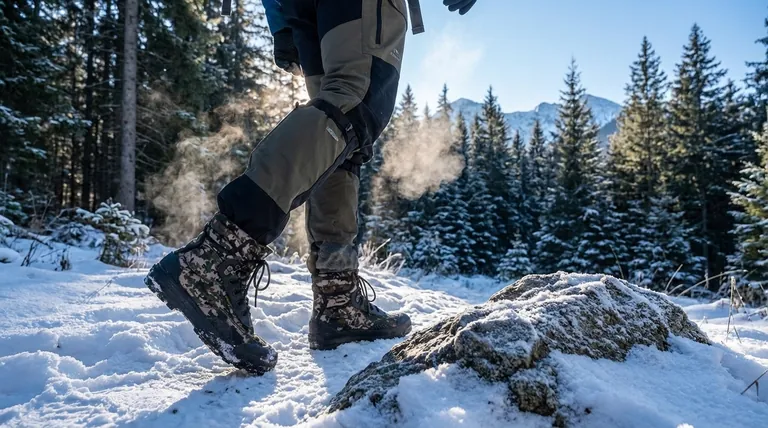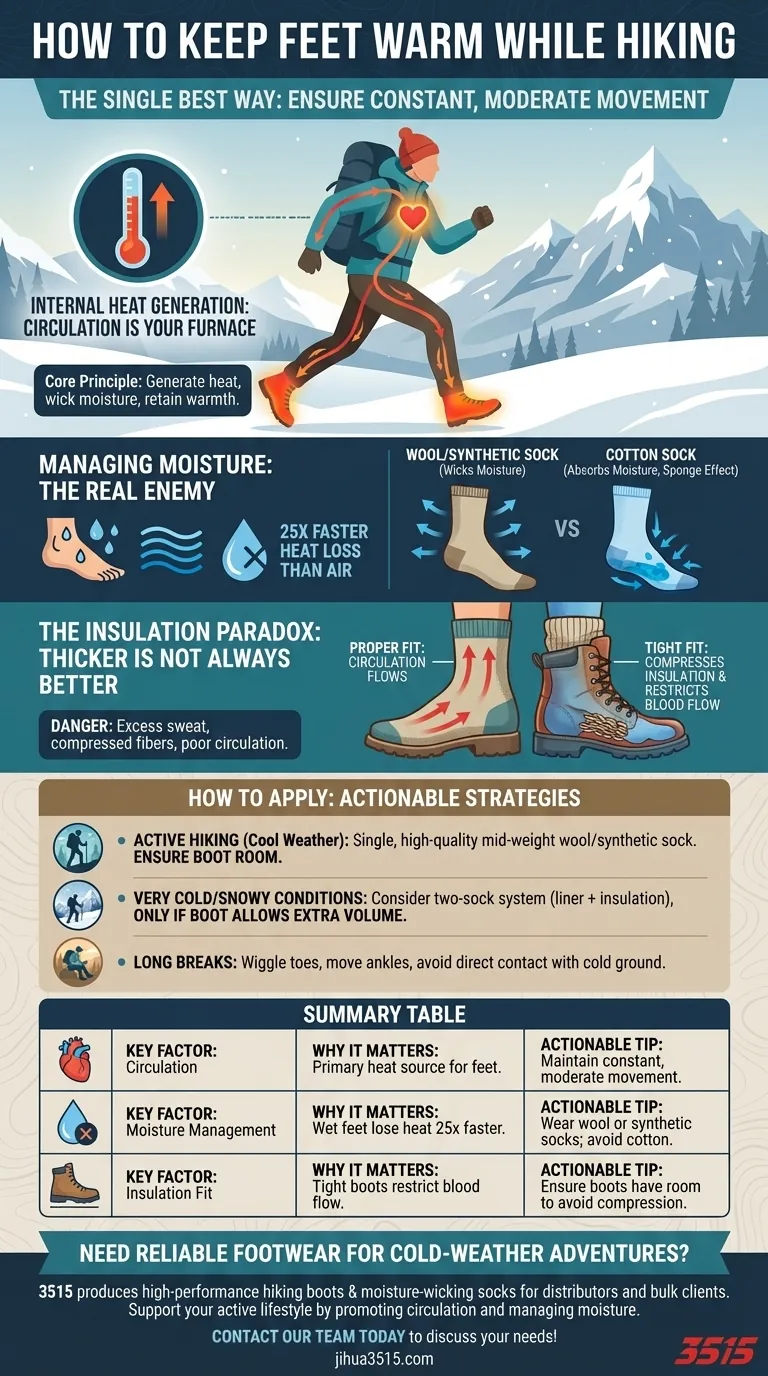The single best way to keep your feet warm while hiking is by ensuring constant, moderate movement. While gear is important, your body's circulation is the primary furnace, and a simple focus on insulation without considering movement and moisture will ultimately lead to colder feet.
The core principle of warm feet is not just adding insulation, but managing a complete system: generating heat through circulation, wicking away moisture to stay dry, and using just enough insulation to retain the heat you've created.

The Foundation: Circulation is Your Furnace
Your body's first response to cold is to protect its core, reducing blood flow to your hands and feet. The only way to counteract this is to generate enough body heat that there's plenty to spare for your extremities.
Why Movement is Non-Negotiable
Constant, moderate hiking forces your heart to pump warm, oxygenated blood throughout your body, including all the way to your toes. This internal heat generation is far more effective than any sock or boot.
The Problem with Stopping
When you stop for a break, this internal furnace throttles down. Your body quickly begins to conserve heat for your core, and your feet are the first to feel the cold.
Managing Moisture: The Real Enemy of Warm Feet
Even in the cold, your feet sweat. If that moisture gets trapped, it becomes the fastest way to lose heat and end up with dangerously cold feet.
How Sweat Makes You Colder
Water conducts heat away from your body about 25 times faster than air. A damp sock, therefore, becomes a highly efficient cooling system, pulling warmth from your skin and leading to a deep chill.
The Critical Role of Sock Material
This is why sock choice is about moisture management, not just thickness. Wool or synthetic socks actively pull moisture away from your skin, keeping you dry. Cotton, in contrast, absorbs moisture like a sponge, guaranteeing cold feet.
Understanding the Trade-offs: The Insulation Paradox
The common instinct is to reach for the thickest socks possible. This is often a mistake that creates the very problem you're trying to solve.
The 'Thicker is Better' Myth
Excessively thick socks can cause your feet to overheat and sweat profusely. As explained above, this sweat becomes trapped, and your feet will inevitably get cold once you slow down or stop.
The Danger of a Tight Fit
Cramming a thick sock into a boot that doesn't have enough room is a recipe for cold feet. It compresses the sock's insulating fibers, making them useless, and—more importantly—it constricts blood flow, cutting your feet off from their primary heat source.
How to Apply This to Your Hike
Your strategy should adapt to your specific conditions and activity level. Focus on creating a balanced system for your feet.
- If your primary focus is active hiking in cool weather: Opt for a single pair of high-quality, mid-weight wool or synthetic socks and ensure your boots are not too tight.
- If your primary focus is hiking in very cold or snowy conditions: Consider a two-sock system (a thin liner to wick moisture, a thicker sock for insulation) but only if your boots are sized to accommodate the extra volume without constricting your foot.
- If you frequently stop for long periods: Wiggle your toes and move your ankles during breaks to maintain circulation, and avoid sitting or standing directly on snow or cold ground.
Ultimately, keeping your feet warm is an active process of managing your body's heat and moisture.
Summary Table:
| Key Factor | Why It Matters | Actionable Tip |
|---|---|---|
| Circulation | Your body's primary heat source for feet. | Maintain constant, moderate movement while hiking. |
| Moisture Management | Wet feet lose heat 25x faster than dry feet. | Wear wool or synthetic socks; avoid cotton. |
| Insulation Fit | Tight boots or socks restrict blood flow. | Ensure boots have room to avoid compression. |
Need reliable footwear for your next cold-weather adventure?
As a large-scale manufacturer, 3515 produces a comprehensive range of high-performance hiking boots and moisture-wicking socks for distributors, brand owners, and bulk clients. Our production capabilities ensure durable, well-fitting footwear designed to support your active lifestyle by promoting circulation and managing moisture.
Contact our team today to discuss your footwear needs and discover how we can support your business or next expedition!
Visual Guide

Related Products
- Wholesale High-Traction Camo Boots - Custom Manufacturer for Brands
- High Performance Fire-Retardant Waterproof Safety Boots
- Factory-Direct Wholesale Canvas Boots with High-Traction Rubber Soles
- Safety Footwear Wholesale Manufacturer for Custom OEM/ODM Production
- Premium Insulated Safety Boots and Shoes for Wholesale & Bulk Orders
People Also Ask
- What are the key features of the new line of camo boots? Built for Extreme Cold & Rugged Terrain
- What technologies are used in the men's 8-inch camo lace-up boots? A Guide to Rugged Outdoor Performance
- How did camouflage use develop during the World Wars? From Artistic Disruption to Scientific Concealment
- Are military camouflage boots waterproof? How to Choose Boots That Keep Feet Dry
- How is PVC produced? From Salt & Gas to a Versatile Polymer



















